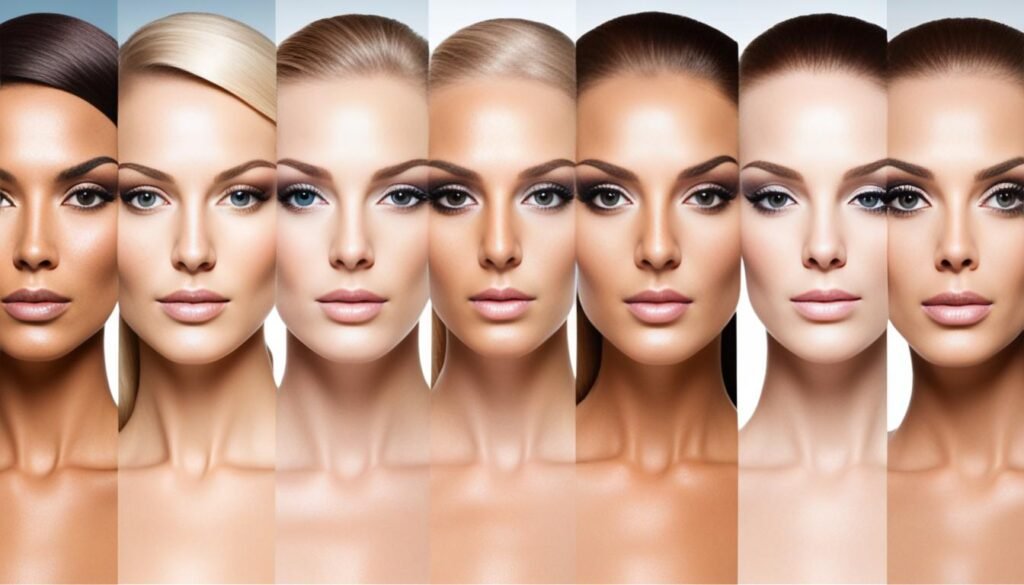Why do people like fair skin?
Have you ever wondered why fair skin tends to be seen as more attractive? Is there a scientific explanation, or is it purely a matter of cultural beauty standards?
Throughout history, fair skin has been associated with concepts like purity, innocence, and modesty. These attributes have deep-rooted connections to societal expectations for women’s appearance and behavior. On the other hand, darker complexions have been linked to notions of sex, virility, and danger.
So, why do these preferences exist? And how much do cultural influences shape our perceptions of beauty? Let’s dive deeper into the fascinating world of fair skin and its allure.
Key Takeaways:
- Fair skin is often considered attractive due to its association with purity and innocence.
- Darker complexions have been linked to concepts like sex, virility, and danger.
- These preferences are influenced by cultural beauty standards and societal expectations.
- Understanding the cultural influences on beauty can help promote inclusivity and acceptance of diverse skin tones.
The Influence of Aesthetic and Moral Judgments
When it comes to beauty, our judgments often go beyond the surface level. While we consciously evaluate physical features like height, weight, and facial features, there is a deeper layer of aesthetic judgments that occur at a subconscious level. Complexion, in particular, is an aesthetic characteristic that is heavily influenced by cultural values and ideals of physical attractiveness.
Lightness and darkness have specific meanings attached to them in our culture, shaping our aesthetic preferences. These preferences, in turn, create links between moral judgments and aesthetic standards. For example, fair skin is often associated with purity and innocence, while darker complexions may be seen as more sensual or even dangerous. This subconscious association between complexion and moral values can profoundly impact our perceptions of beauty.
“The scale of differences in skin color attractiveness between men and women is not solely explained by biology but by deeply rooted cultural values.”
It is essential to recognize that the differences in skin color attractiveness between men and women cannot be solely attributed to biological factors. Rather, deeply rooted cultural values play a significant role in shaping these preferences. Cultural standards of beauty influence our perception of physical attractiveness and establish specific ideals that individuals strive to meet.
By understanding the influence of aesthetic and moral judgments on our perceptions of beauty, we can gain insight into the complex interplay between culture and physical attractiveness ideals. This recognition also allows us to question and challenge the rigid beauty standards that may perpetuate discrimination and limit inclusivity.
Subconscious Level and Cultural Influence
Our subconscious level of judgment goes beyond mere surface-level evaluations. The meanings attributed to complexion within our culture shape our aesthetic preferences and contribute to the overall beauty standards upheld by society. Scratch the surface, and you’ll find a network of values and beliefs dictating our perception of beauty.
The link between morality and aesthetics is not confined to the realm of complexion. However, the impact of cultural values on complexion-related judgments is particularly pronounced. These judgments extend beyond superficial physical attributes and are deeply intertwined with our deeply rooted cultural values.
- Cultural values shape our aesthetic preferences
- Complexion holds moral connotations
- Skin color attractiveness influenced by deeply rooted cultural values
Moreover, the divergence in skin color attractiveness preferences between men and women cannot be solely attributed to biological differences. Instead, societal norms and cultural values play a vital role in shaping these preferences, influencing the ideals of physical attractiveness upheld by both genders.
Aesthetic Preferences and Cultural Values
Our overarching cultural values influence the development of aesthetic preferences, including those related to complexion. These preferences are deeply ingrained within us, impacting our judgment of beauty at a subconscious level.
Throughout history, diverse cultural beauty ideals and standards of physical attractiveness have emerged. These ideals reflect the cultural values and beliefs prevalent within each society. By examining these beauty standards, we can gain a deeper understanding of the subconscious influence cultural values exert on our perception of beauty.
“The scale of differences in skin color attractiveness between men and women is not solely explained by biology but by deeply rooted cultural values.”
There exists a complex interplay between aesthetic preferences, moral judgments, and cultural values. This interplay shapes our perception of beauty, particularly concerning complexion. By acknowledging the influence of cultural values on our aesthetic ideals, we can challenge rigid beauty standards, promote inclusivity, and celebrate the diversity of skin tones.
Beauty Ideals and Skin-lightening Practices
Fair skin has long been upheld as a beauty norm in various societies, reinforcing the notion that lighter skin is more attractive. This preference for fairness is particularly evident in African-American and Indian cultures, where there is a clear association between light skin and beauty, while darker skin tones are often deemed unattractive.
These beauty norms go beyond personal preferences and are deeply rooted in racial and color hierarchies. They reflect societal values that prioritize lighter skin as a desirable trait and perpetuate discriminatory ideals. The emphasis on fair skin can lead to immense societal pressure to conform to these standards and can contribute to feelings of inferiority and self-consciousness among individuals with darker complexions.

Within these cultural contexts, the desire for fair skin has fueled the rise of skin-lightening practices. People turn to bleaching products and other methods to achieve a lighter complexion in their pursuit of beauty. These practices are driven by the belief that fair skin is not only aesthetically pleasing but also holds social and economic advantages.
However, it is crucial to recognize that the promotion and normalization of skin-lightening practices perpetuate discrimination and reinforce existing social hierarchies based on race and color. By adhering to these beauty ideals and resorting to drastic measures to alter one’s natural complexion, individuals inadvertently contribute to a system that values certain physical traits over others, deepening the divide and reinforcing harmful stereotypes.
To challenge these beauty norms and foster inclusivity, it is essential to celebrate the diversity of skin tones and promote acceptance of all shades. Embracing different complexions and challenging color hierarchies can help dismantle the discrimination associated with beauty standards and foster a more inclusive society.
Skin-lightening Ingredients to Avoid
When considering skin-lightening products, it’s crucial to be aware of the harmful ingredients that may be present. These ingredients can have adverse effects on your skin and overall health. Here are some commonly used ingredients to avoid:
- Hydroquinone: This chemical can cause skin irritation and has been linked to a higher risk of skin cancer.
- Steroids: Prolonged use of steroid creams for skin lightening can lead to thinning and discoloration of the skin, as well as other side effects.
- Mercury: Mercury is a toxic substance that can damage the kidneys, nervous system, and skin. Look for mercury-free products.
Always prioritize your health and well-being when making decisions about skincare. Instead of striving to change your natural skin color, embrace and celebrate the unique beauty that comes with your natural complexion.
Conclusion
The preference for fair skin is deeply ingrained in cultural beauty standards and influences our moral judgments. Men are often attracted to fairer skin, which is associated with notions of purity and innocence. On the other hand, women’s preference for darker complexions can be attributed to societal perceptions of danger and sex appeal. These preferences are not solely based on biology but are shaped by the cultural values we hold.
However, these beauty ideals can also lead to discrimination and create societal pressure to conform to certain standards of attractiveness. Fair skin is often seen as the epitome of beauty in many societies, while darker skin is considered less desirable. This perpetuates color hierarchies and can reinforce existing racial and social biases.
Unfortunately, these beauty standards have fueled the rise of skin-lightening practices. Many individuals, influenced by societal norms, resort to bleaching products in an attempt to achieve fair skin. While it is a personal choice, these practices can perpetuate discriminatory beliefs and further marginalize those with darker skin tones.
It is crucial to recognize the cultural influences on beauty standards and strive for inclusivity and acceptance of diverse skin tones. Embracing the beauty of all skin colors helps challenge discriminatory beliefs and promotes a more inclusive society, where individuals are valued for their unique features and not confined to narrow beauty standards.






